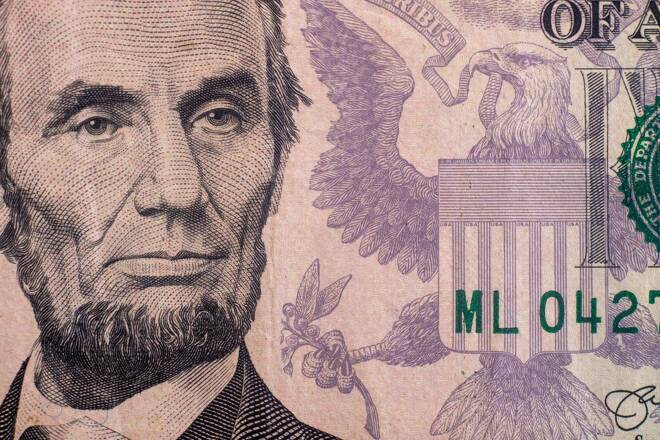Fitch Downgrades US: What You Need to Know
By:
The US has lost its top-tier AAA credit rating as assigned by Fitch Ratings, now downgraded down one level to AA+.
US Treasury Secretary Janet Yellen “strongly disagreed” with Fitch’s decision, blasting it as “arbitrary and based on outdated data”.
But that hasn’t stopped global markets from adopting a slightly risk-off mode for the time being:
- US stock futures are falling to extend August’s losses so far
- Gold is edging higher though still trading around the mid-$1900s
- The safe haven Japanese Yen is the only G10 currency to climb against the US dollar
However, the full fallout directly from this downgrade should prove to be limited and short-lived.
Read on to find out more.
What Does Fitch Ratings Do?
Fitch Ratings assigns a credit rating to various entities that issue debt, ranging from governments to corporates.
- Fitch’s highest rating is ‘AAA’, which means the country/company has the lowest risk of defaulting, i.e. has an “exceptionally strong capacity” to meet its financial commitments, such as paying interest on a bond.
- The lowest rating is ‘D’, which is assigned when the debt issuer has entered into bankruptcy proceedings.
This credit rating points to the financial strength and ability to meet debt commitments, such as making interest payments on bonds issued.
How Do Investors Use These Credit Ratings?
Global investors rely on these credit ratings to decide which country’s debt to buy:
- Debt with the ‘AAA’ through ‘BBB’ ratings are deemed as investment grade (low to moderate risk of default).
- Debt issuers with ‘BB’ and lower ratings are deemed as “speculative grade” (high risk of default, i.e. not able to meet its payment obligations).Investors with a higher tolerance for risk may buy such debt with lower credit ratings, as they tend to offer higher yields to compensate investors for the greater risk of default.
In short, the higher the credit rating, the “safer” the investment is deemed, and vice versa.
Why Was the US Downgraded?
The US was downgraded because Fitch Ratings expects the following:
- “Fiscal Deterioration”: US government’s financial strength to worsen over the next 3 years.
- “Rising Deficit”: US government set to spend more money at a faster pace than it can generate income (taxes), resulting in a bigger budget gap.
- “Erosion of governance”: the repeated debt-ceiling standoffs in US Congress elevates the risk of a first-ever US default, which was only just narrowly avoided this past May.
This downgrade is a follow-through on Fitch’s warning, made back in May, amidst the US debt ceiling drama.
Fitch Rating’s full statement can be found here.
Has This Happened Before to the US?
Yes, almost exactly 12 years ago.
The US experienced its first-ever credit rating downgrade back in August 2011, by S&P – another credit ratings agency.
Hence, given that Fitch’s move is not unprecedented (we’ve seen it before over a decade ago), nor does it unveil anything startling that market’s don’t already know, that should explain the relatively muted reaction in the markets.
Are markets Reacting as Expected?
Yes, but not without a tinge of irony.
Amidst the risk-off moves mentioned at the top of this article …
the US dollar – the world’s “preeminent” reserve currency – is also gaining against other currencies, including many of its G10 and emerging-market counterparts.
Why Is the USD’s Strength ‘ironic’?
Typically, if a country’s credit rating is downgraded, the initial reaction would be for investors to shy away from its assets and currency.
But this is the United States that we’re talking about here – the world’s largest economy!
After all, global financial markets and investors have long seen US Treasuries (debt issued by the US government) as the “golden-standard” for risk-free assets.
Hence, investors have been flocking to shorter-term US Treasuries (yields on 2-year and 5-yearTreasuries are moving lower) as such “safe haven” assets help investors protect their wealth amid times of uncertainty.
Ironic, given that Fitch Rating’s downgrade actually casts doubt over the US government’s ability to meet its debt obligations.
How Long Will The Risk-off Mode Last?
Not long, probably.
At least in terms of whatever market reaction that can and should be attributed to today’s decision by Fitch Ratings.
After all, long-time investors will point to how the S&P 500 – the benchmark for US stock markets – recovered all its losses within 6 months after that first-ever US credit ratings downgrade back in August 2011.
Back then, the S&P 500 surged by nearly 30% between that August 2011 intraday trough until that peak in early-April 2012.
In today’s context, investors appear to have greater concerns at present.
The likelihood of a global recession and the risk of further Fed rate hikes – these factors are set to be the greater catalyst for a sustained risk-off mode across global financial markets, rather than Fitch’s downgrade of the US.
For more information visit FXTM.
About the Author
Han Tancontributor
A highly experienced financial journalist and producer with more than seven years of experience gained across some of Southeast Asia’s (SEA) most prominent business broadcasters.
Did you find this article useful?
Latest news and analysis
Advertisement
